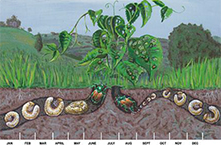Includes over 300 different species.
Lindens, Birch, Norway Maples, Fruit trees and Roses
DAMAGE:
Adults often feed in a group, skeletonizing leaves with only a network of veins remaining when feeding damage is heavy. Larvae are most commonly found feeding on the fibrous roots of turfgrass.
DESCRIPTION AND LIFECYCLE:
Look for adult beetles in late June to early July, as Littleleaf Linden begins bloom and Hills of Snow hydrangea is in full bloom. They are metallic green and copper approximately 13 mm long. There are 6 tufts of white hair on each side of the abdomen that distinguishes them from rose chafers and the false Japanese beetle.
Larvae are C-shaped milky-white grubs (about 25mm long) with brown heads and 3 pairs of legs. Japanese beetle larvae are distinguishable from other white grub species by a V-shaped arrangement of spines on the underside of the abdomen.
CONTROL MEASURES:
- Beetles are attracted to plants damaged by feeding, so control damage early.
- Pheromone and bait traps are not recommended as a strategy for trapping beetles.
- Apply approved insecticides to the soil when grubs are young and actively feeding near the soil surface or during the mating period/egg laying period and up to egg hatch (usually late June/early July). Irrigate to wash the insecticide into the underlying soil.
- Use approved adulticides when adults appear in early July, when the Yucca filamentosa is blooming.



REFERENCE: Publication 383, Pocket IPM Scouting Guide for Woody Landscape Plants By Diane Brown-Rytlewski
